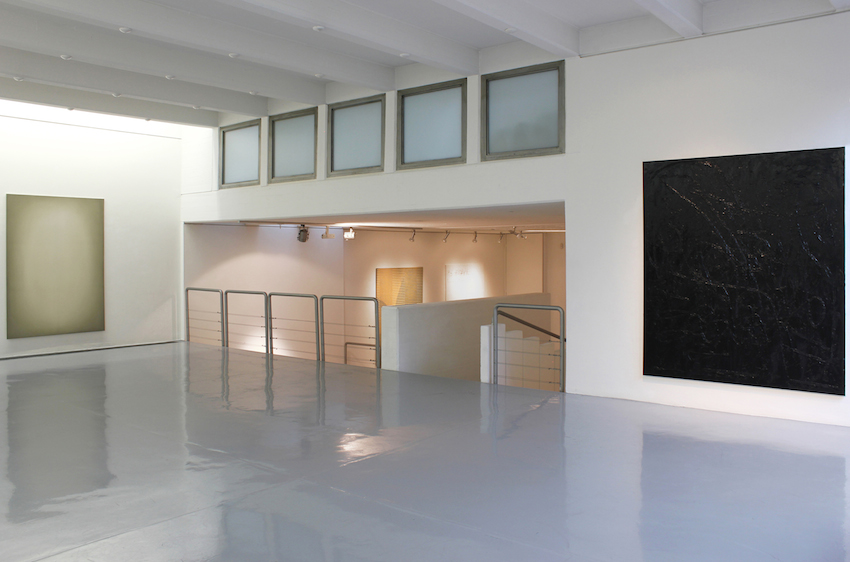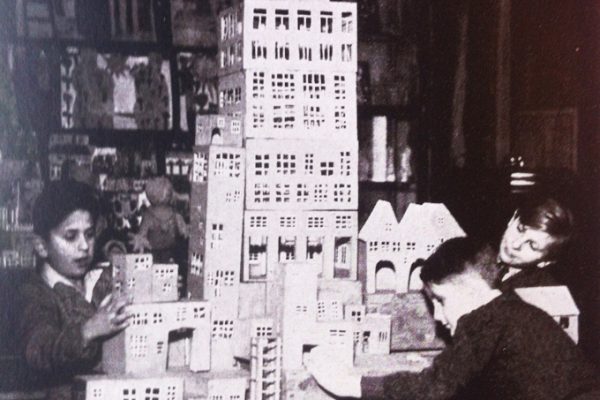
The Abstract Turn
/ DE /
Back to Abstraction – An essay by Noemi Smolik
Just before the end of the year, Cologne gallerists Alexander Warhus and Luisa Rittershaus presented a striking exhibition of painting in the former spaces of Galerie Zwirner, today the project space WERTHEIM. The 10-day exhibition showed works by young artists living in the Rhineland, who, alongside the visual formats set by the curators, almost all the same size, had one thing in common: abstraction. But why are young artists today so interested in abstraction? And what fascinates their collectors?

links: Sabrina Fritsch, Stst (acea), 2013, Öl, Acryl auf Rupfen auf Leinwand, 220 x 165 cm, Courtesy VAN HORN; rechts: Chris Succo, I want everything fun always to happy, 2014, Öl und Lack auf Leinen, 230 x 172,5 cm, Courtesy Almine Rech Gallery; Foto: bildpark.net
It was surely also due to the historic location that the exhibition was able to assert a spirit of the time with its 17 canvases, each in self-confident formats of around two by two meters. And yet, the artistic styles gathered here couldn’t have been any different from one another: black, nearly monochromatically applied pigments of aluminum by Philip Seibel encountered blue ramifications and struts by Martin Weidemann and the seemingly spontaneous, applied, fragile constructions of Matthias Schaufler. Andreas Breunig’s surreal visual worlds and the fairy-tale striations of Jan-Ole Schiemann opposed the strict pictorial surfaces of Peppi Bottrop, covered with lines, while the inter-linked squares by Stefan Müller opposed the strips on nettle dissolving in blithe color strips by Ralf Schauff. In contrast, there was hardly anything to be seen on the canvas of David Ostrowski, who presented white paper on white canvas.
Just as different as the motives are the stories of the pictures’ emergence: while Sabrina Fritsch creates precise, geometric spatial structures, Fabian Herkenkörner’s works result from dragging the canvasses across the dirty floor.

von links: Martin Weidemann, Zimmer Nr. 4 (Detail), 2014 Öl auf Leinwand, 200 x 170 cm, Courtesy Warhus Rittershaus; Matthias Schaufler, Ohne Titel (K2), 2014, Öl auf Leinwand, 210 x 190 cm, Courtesy Galerie Hammelehle und Ahrens; Philip Seibel, Tafel 25 (Fluß und Floß), 2014, Öl, Pigment und Lack auf Aluminium 220 x 145 cm, Courtesy Berthold Pott; Jan-Ole Schiemann, Fusel, 2014, Öl auf Leinwand 180 x 155 cm, Courtesy the artist; Foto: bildpark.net
The Cologne exhibition represents a trend in contemporary art that will continue going strong this year as well. Abstract painting is currently enjoying great popularity. The sums being achieved for works of abstract painting—especially by young American artists at international auctions—are breathtaking. But even the paintings of Cologne-based David Ostrowski, born in 1982, now sell for more than 250,000 dollars, and the paintings of the Columbian artist Oskar Murillo, born in 1986, sell for almost twice the price. Alex Israel from LA, who is just 31, has already broken the million-dollar mark with one of his canvases.
The museums are also reacting unusually quickly, since the young abstract artists join in the over 100-year-old tradition of organic and geometric formal language. For example, London’s Whitechapel Gallery just opened the exhibition “Abstract Art and Society 1915 -2015,” that reflects on the young stars as heirs of Malevich’s Black Square. MoMA is currently showing “The Forever Now: Contemporary Painting in an Atemporal World” with works by Murillo and Matt Connors’ monochromatic canvases with the title What Is the Third Question?, an allusion to Barnett Newman’s legendary painting Who’s Afraid of Red, Yellow and Blue from 1970.
Art market experts make things too easy for themselves when they explain the current boom of abstract painting with the emergence of a new group of collectors who buys art to sell it as soon as possible at a profit: “Artflipping,” the new form of profit maximization. Although it’s true: Murillo’s paintings, which today sell at six-number sums, were just two years ago only worth 40,000 dollars. Flatware is still the most lucrative,
investors know.

von links nach rechts: Markus Golz, Alla Prima / WBiN 4, 2014, Öl, Acryl und Lack auf Leinwand 180 x 130 cm, Courtesy Warhus Rittershaus; Ralf Schauff, Untitled, 2014, Acryl auf Nessel, 180 x 130 cm, Courtesy the artist; Peppi Bottrop, All nine, 2014 Graphit auf Leinwand 250 x 210 cm, Courtesy Jan Kaps; Foto: bildpark.net
But many art critics in contrast are skeptical, and speak of a brief, market-made trend. In the face of the repeated pronunciation of the “death of painting,” Walter Robinson calls these abstract artists “zombies.” Jerry Saltz blames the “greedy” market for the “copycat mediocrity” and himself falls into the trap of always blaming the market.
Other critics however, like André Rottmann, diagnose a “striking resilience” in this boom of the painted canvas. But where does this resilience come from? And why of all things abstract painting? Isn’t there enough pop-figurative material on the market that can also satisfy erotic longings?
Today’s abstract painting, or so it seems, refers increasingly to the ideals of its classical predecessors and thus distances itself consciously from what since the 1990s has been abbreviated under the term participatory art.
Abstract painting was considered the climax—some even speak of the culmination—of a development called modernism and whose final branches stretched into the 1970s. In this development, artists were seen as heroes who valiantly took up the struggle with the canvas—and it was almost exclusively the canvas. An individual style that could be judged by aesthetic criteria was the prerequisite of success. The linked burden of individual responsibility was so heavy for some artists that they often sought relief in alcohol, and Jackson Pollock or Mark Rothko were even driven to suicide.

links: Fabian Herkenhöner, WO111 (Dynamism of a dog on a leash), 2014 Staub auf Leinwand, 200 x 150 cm, Courtesy the artist,; rechts: Jan Pleitner, as yet untitled, 2014, Öl auf Leinwand, 190 x 130 cm, Courtesy Ancient & Modern / Natalia Hug Gallery; Foto: bildpark.net
These artists truly took a position, by relying on a style all their own subject to their own aesthetic criteria, quite different from today’s artists, who usually enjoy institutional support.
In the belief that it promotes creativity, participative art relies on collective collaboration. It generates situations for the beholder that are intended to promote communication, understanding, a sense of well-being, and even a readiness to help. In judging their social acts—discussions, walks, a joint meal—the artistic characteristics as such are not decisive, but rather the social impact of an action.
Such an aestheticization of interaction has in the meanwhile reached the institutions, and takes place on the streets; protest movements like “Occupy” or the recent demonstrations in Hong Kong increasingly resemble an artistic performance. Artist, curator, and museum director Peter Weibel coined the fitting term “global artivism” for the current entanglement of art, politics, business, communication, and scholarship. In light of these blurred lines separating the aesthetic and the social, art is threatened with losing its critical attitude, as art critic Clair Bishop warned in her 2006 essay “The Social Turn: Collaboration and its Discontents.”

von links: Andreas Breuning, S-Works: specialized No. 32 , 2014, Öl, Kohle und Graphit auf Leinwand, 210 x 170 x cm, Courtesy Warhus Rittershaus; David Ostrowski, F(3), 2014, Lack und Papier auf Leinwand, Holz 240 x 190 cm, Courtesy Peres Projects; Thomas Arnolds, LUFT 2, 2012, Öl auf Leinwand, 250 x 200 cm, Courtesy Galerie Hammelehle und Ahrens; Daniel Schubert, Untitled (aus der Serie ´Lay in a Shimmer`), 2012, Eitempera auf Leinwand, 210 x 150 cm, Courtesy Galerie Gebr. Lehmann; Foto: bildpark.net
Current abstract painting resists the imperative of the collective and participation. In a society that is networked, where constant participation, reaction, response, and involvement is demanded, it refuses the terror of never-ending communication in the aesthetic realm. Instead, these young artists invite to take pause and engage in concentration. Their works do not demand connoisseurship, but can be understood by the beholder as formally attractive. In this way, many artists once again emphasize aesthetic distance, without making it all too difficult for us to build up an associative, sensual proximity to these works. This explains why the young artists control the free market, while participative art, with few exceptions, requires the protective hand of institutions. The ideals of modernism are what led to developments of ever more autonomy, creativity, flexibility, readiness to take risks, and to accept responsibility in our post-capitalist society, according to sociologists Luc Boltanski and Ève Chiapello.
Accordingly, the successful homo oeconomicus today, and this means the collectors of abstract art, increasingly appropriate the characteristics of a modernist artist, whose aesthetic expression was abstract painting. Abstract art ultimately represents an individualism that was rejected over the past twenty years of a so-called relational aesthetic.

links: Daniel Schubert, Untitled (aus der Serie ‘Lay in a Shimmer’), 2012 Eitempera auf Leinwand, 210 x 150 cm, Courtesy Galerie Gebr. Lehmann; rechts: Jana Schröder, Spontacts CH M5, 2014 Öl auf Leinwand, 210 x 180 cm, Courtesy the artist; Foto: bildpark.net
In a networked, interlinked society, distance has become one of our most precious goods. Here, abstract visual language represents currently the greatest distance to everyday life. According to French philosopher Jacques Rancière, “A critical art is an art which knows that its political impact depends upon its aesthetic distance.” In this way, current abstract art not only satisfies a longing for deceleration and contemplation, it represents a critical position in its less obvious political attitude.






